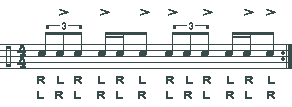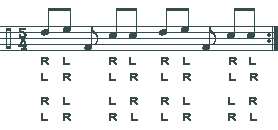
These exercises are primarily Single-Strokes between the left and right hands. I have intentionally avoided any double-stroke patterns (which we will take up at a later date) because they are a completely separate drumming discipline.
You will notice an emphasis on accents. I considered calling this lesson "Accents", but we can spend more profitable time working on accents when we add double- and triple-strokes. However, accents are crucial in developing control, so pay attention to them and don't ignore them; play them!
![]()
![]()
The single-stroke is the most common drum pattern, so that's where we will start. If you haven't warmed up properly yet, better do so now!
Drummers learn single-strokes before they learn anything else. And if the drummer is primarily self-taught, there is a very real possibility that single-strokes will make up his or her primary drumming vocabulary. We'll correct this problem in future lessons, but for now let's attempt to make sure that the single-strokes we're playing are more challenging that simple R-L-R-L quarter notes.
As always, these exercises are meant as a starting point: you are encouraged to develop them further.
![]()
![]()
First, let's engage in a little bit of single-stroke warm-up. Play the following exercise at a slow tempo and repeat, gradually increasing the tempo until you are pushing your limit; then slow back down. Also repeat in reverse: quarters, eighths, triplets, sixteeneth, sixteenths, triplets, eighths, quarters, etc. Do each three times.
Note the triplets! Play them. Also note that you play both bars before repeating (since there is a simple bar line at the end of the first staff, you continue on the next staff until you hit a repeat or a full stop).

Single-Stroke #1
The first exercise is a simple single-stroke roll with no accents. Play three times, each time starting slow, getting faster until you reach your limit, then pushing past your limit for a count of 60, then slowing down. These are conditioning exercises.

Single-Stroke #2
Now we're going to begin accents. Note that the meter is in four, but the accents are in three. Play as above, three times, slow-to-fast-to-slow.

Single-Stroke #3 & #4
Now we're in 5/4. Note the accents initially come at unpredictible places. Do as above for both exercises.


Single-Stroke #5
Now we add some rests, which are trying to be in four. Keep counting in five, though, and pay attention to the accents, which skip each played beat by three! Do as above.

Single-Stroke #6a&b & #7
In the first two exercises (#6a & #6b) some triplets are thrown in to the mix. #6b replaces the fourth eighth note with the bass drum.
Then in the next exercise (#7) we throw some eighth notes at you. Do as above for both exercises: slow-fast-slow, three reps.



Single-Stroke #8 & #9
OK. Now, we're getting off the snare drum and working on the toms. No more accents! Sticking is paramount here: if you have to cross, cross! Do as above for both exercises.


Single-Stroke #10
Let's add the bass drum. These are in 5/4! It might feel a bit odd at first, but stick with it. Notice the "false" doubles in the bottom two sticking lines: same-hand strokes separated by the bass drum. Do as above.

Single-Stroke #11 & #12
Triplets again. Watch out for the eighth-note rest! This should throw you out of your comfort zone. The second exercise goes back to 4/4. so it should play a bit smoother (again, we have the "false double-strokes" in the bottom two sticking lines). Do as above.


Single-Stroke #13
Back to the snare with accents. Mixing things up a bit. Do as above.

Single-Stroke #14
This pattern can also be found on my Rhythms of Prog page. It is "B'boom" by Bill Bruford and is from King Crimson's THRACK album. I've included it here because it really stretches the accent vocabulary. Play it around the set like a solo.
Pay attention to the accents and the hi-hat. Try playing it without the bass drum reinforcing the accents.
Do each as above: slow-fast-slow, three reps.

![]()
![]()
As always, feel free to develop your own single-stroke exercises. The object here is to stretch the single-stroke concept beyond whatyou're comfortable with now. If you have any cool single-stroke exercises you want to share with others, drop me a line!
![]()
![]()
![]()
